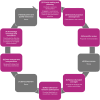Patient engagement strategies in digital health interventions for cancer survivors: A scoping review
- PMID: 40446002
- PMCID: PMC12124549
- DOI: 10.1371/journal.pdig.0000871
Patient engagement strategies in digital health interventions for cancer survivors: A scoping review
Abstract
Individuals can face various mental and physical health challenges after a cancer diagnosis. Digital health platforms can address some of these challenges by providing self-management tools for improving lifestyle behaviors, while reducing the burden on healthcare systems and enhancing healthcare access to underserved populations. Involving individuals with a history of cancer, termed here as "cancer survivors", in the development and evaluation of digital health platforms can improve their effectiveness. This scoping review aimed to explore the state of patient engagement in research on digital health platforms for cancer survivors, including strategies for engagement, characteristics, and identifying gaps and barriers. A systematic search was conducted in OVID Medline, OVID EMBASE, and Scopus from inception until May 2023. The review followed Joanna Briggs Institute's guidance for scoping reviews. Eligible studies actively involved cancer survivors in the development or evaluation of digital health platforms. These studies focused on self-management digital health platforms delivering nutrition, physical activity, and/or mental health interventions. Reporting of patient engagement was evaluated according to the Guidance for Reporting Involvement of Patients and the Public 2 (GRIPP2). The search strategy captured 7 studies using various patient engagement approaches, with patient and public involvement being the most frequently used (43%, n = 3). Studies were conducted in 6 countries and most focused on the development or evaluation of web-based digital health platforms (71%, n = 5). Few studies reported all elements of GRIPP2's reporting checklist (29%, n = 2). We further identified barriers and areas of improvement for patient engagement in digital health research. Patient engagement improves digital health platforms, but few studies have meaningfully included patients, therefore reporting and evaluation of patient engagement is necessary to support its adoption in digital health research projects. In addition to exploring the gaps in patient engagement practices, this scoping review serves as a foundation for future research to advance patient-oriented digital health interventions for cancer survivors.
Copyright: © 2025 Ren et al. This is an open access article distributed under the terms of the Creative Commons Attribution License, which permits unrestricted use, distribution, and reproduction in any medium, provided the original author and source are credited.
Conflict of interest statement
The authors have declared that no competing interests exist.
Figures



Similar articles
-
Beyond the black stump: rapid reviews of health research issues affecting regional, rural and remote Australia.Med J Aust. 2020 Dec;213 Suppl 11:S3-S32.e1. doi: 10.5694/mja2.50881. Med J Aust. 2020. PMID: 33314144
-
Understanding Engagement Strategies in Digital Interventions for Mental Health Promotion: Scoping Review.JMIR Ment Health. 2021 Dec 20;8(12):e30000. doi: 10.2196/30000. JMIR Ment Health. 2021. PMID: 34931995 Free PMC article.
-
Guidance for engagement in health guideline development: A scoping review.Campbell Syst Rev. 2024 Nov 25;20(4):e70006. doi: 10.1002/cl2.70006. eCollection 2024 Dec. Campbell Syst Rev. 2024. PMID: 39588485 Free PMC article.
-
Assessing and Enhancing Nutrition and Physical Activity Environments in Early Childhood Education and Care Centers: Scoping Review of eHealth Tools.JMIR Pediatr Parent. 2025 Jan 22;8:e68372. doi: 10.2196/68372. JMIR Pediatr Parent. 2025. PMID: 39841984 Free PMC article. Review.
-
A scoping review of stroke services within the Philippines.BMC Health Serv Res. 2024 Aug 30;24(1):1006. doi: 10.1186/s12913-024-11334-z. BMC Health Serv Res. 2024. PMID: 39215352 Free PMC article.
References
-
- National Cancer Institute. Cancer survivorship. 2014. [cited 2023 December 15]. Available from: https://www.cancer.gov/about-cancer/coping/survivorship
LinkOut - more resources
Full Text Sources
